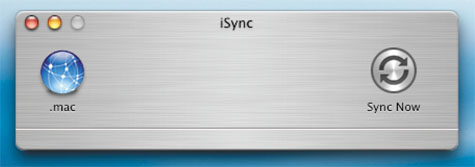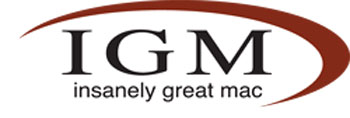iSync: Using .Mac to Synchronize Multiple Macs
October 4th 2002
Apple's iSync is an ambitious application intended to synchronize its customer's digital lifestyle. The application is designed to sync up data from Apple's Address Book and iCal applications between a Mac and cell phone, PDA, other Macs and even the iPod.
When it was announced, I was instantly attracted to the concept because one pain in my life is keeping information current between my computers. One of my biggest challenges is trying to keep a unified set of addresses.  When Mac OS 10.2 came out, I took a step in the right direction by moving over to the built-in Address Book. Apple's Address Book is more than just a place to keep names and numbers. Apple smartly uses the Address Book as a hub of information that can be used throughout the operating system, for example address are available in Mail and iChat, Apple's email and instant messaging applications. Even iCal gets in on the action, allowing you to invite contacts for meetings or events. It's not just Apple products either, as third-party software such as FaxSTF link to the Address Book.
When Mac OS 10.2 came out, I took a step in the right direction by moving over to the built-in Address Book. Apple's Address Book is more than just a place to keep names and numbers. Apple smartly uses the Address Book as a hub of information that can be used throughout the operating system, for example address are available in Mail and iChat, Apple's email and instant messaging applications. Even iCal gets in on the action, allowing you to invite contacts for meetings or events. It's not just Apple products either, as third-party software such as FaxSTF link to the Address Book.
Before we get going, it's worth noting that iSync is still in development. I've witnessed a number of problems, some with iSync, some with .Mac. It works well, but you might want to be prepared for it not to work, only to try and succeed later. Oddly, Apple has a humorous note in its documentation stating that the software is beta and users should take precautions by backing up data before installing iSync. To accomplish this Apple recommends that "You should back up important data before you install and use it. To back up your data, you can use the menu command in iSync." Perhaps the folks at Apple are just testing to see if anyone actually reads their documentation.
Information Conundrum
My problem is an old one. I get and use information in multiple locations. I might enter an address on one computer, while putting in a phone number in another. Then inevitably, I would need a bit of information that was in one place, but not the other. The only remedy is to sit down regularly and manually coordinate the data making sure everything is the same everywhere.
iSync has changed this. Just last week I wrote about whether .Mac is worth the cash. At the time, I was speculating on what iSync would do for connecting Macs together, assuming it would just replace data files from one computer to the other. Lowered expectations make for pleasant surprises. iSync thankfully is much more. iSync does precisely what I need, which is matches up additions, deletions and modifications among all devices, including other Macs.
For example, lets say we have a desktop and a laptop. While in the office you often read/add/delete/modify contacts and appointments. On the road, you do the same on the laptop. Previously you'd needed to essentially keep a master set of information on one computer, which you would ensure was always up to date so that you could copy over to the other computer. With iSync, that's no longer a concern. Lets say one day you add two contacts on the desktop, and then modify and delete a contact on the laptop. When you sync each computer up they will eventually share the same changes -- two additions, one modification and one deletion. Note you'll have to do three syncs in total, one for the desktop, one for the laptop to match the desktop, then a final on the desktop to match to the laptop changes.

iSync takes steps to ensure the correct data is always used. Obviously with records coming from multiple locations, it's very possible to have multiple version of a given record. Apple says iSync uses the most recent version of any records. Additionally, if a conflict does occur, iSync gives you the option to choose which record to keep. Finally, on any sync-up, iSync will display a summary of what's being done, giving the user the final authorization to catch anything that may have gone astray. When I was getting iSync going the first time, I had a couple records that I need to sort out, but after that there has been no mix-ups between syncs.
The implications of iSync are huge for anyone with a Mac at home and at work, or use a second Mac as a mobile combo. There are other solutions in the world, but most of those require a live Internet connections to access information. iSync requires an Internet connection only for the occasional linkup.
Big Picture
With that said, this is only one component of the iSync solution. While keeping multiple Macs up to date, you can easily also keep a cell phone and PDA current. Even the iPod can hold addresses and appointments. So while linking two computers is very interesting, the one-two punch is using the same setup for connecting other devices.
I've never been much of a PDA person. It's just another thing to carry around. I have a Palm III, and I don't even know if it's possible to link up to iSync. The Palm gets a workout at Macworld Expo, and spends the rest of its days in a drawer. If anyone got a Palm III going, with a G4/10.2/iSync, I'd be curious to try. For the most part, however, a cell phone can hold my essential information.
Speaking of cell phones I am on the other hand seriously considering picking up a Sony/Ericsson T68i phone. I keep a lot of phone numbers in my cell phone and often spend the time keeping things up to date. An T68i with Bluetooth would make a sweet trifecta. From what I understand, the T68i address book allows names, numbers and an email address. I really wish a cell phone would come out to also include street addresses, which for me would effectively wipe the need for a PDA. I'm looking at Voicestream T-Mobile service in Michigan, if anyone has any comments about the service or phone, I'm be interested to listen.
As a side note, it would be interesting to see if other third-party applications were able to utilize iSync for data synchronization. Any email, calendar or contact manager would be a candidate, specifically Microsoft Entourage. Also interesting might be Web browser bookmarks, Web site passwords and who knows what else.
The .Mac connection
Ah here we are again talking about .Mac. To use iSync between two computers, a .Mac account is required. Kindly, Apple has extended the free .Mac period a couple weeks so that we all can marvel at what is iSync. Essentially iSync places the data on .Mac as a middle man for the designated synced computers. When you set up the .Mac sync, you register the computer by its name, which then lets you view other computers registered under your .Mac account. If you have more than two Macs, you can obviously sync them all through here.
In my opinion one short fall of iSync is it does not interface with .Mac's Webmail. I'm astonished that the my addresses don't show up on Webmail. Unless there's some unseen technological roadblock, I'll assume Apple missed that idea and hopefully will show up soon. It would be very convenient to log into .Mac via a browser from anywhere and get a phone number, or even just have an address available to email.
The .Mac requirement, however, is yet another sore spot with some Mac users. At first there was some speculation that iSync would directly connect to computers via Ethernet to do the sync. This could work, but not particularly practical. Obviously both computers would have to be online at the same time, and neither could be behind a firewall. This would be more realistic across a LAN, but I think Apple envisioned a more common denominator solution where not everyone is always online via broadband and has access to configure their firewall.
Yet another option floated was the ability to save .Mac access to any Internet storage, via FTP, WWW, or WebDAV, or whatever. This is a pretty good solution, but not the one-click wonder that is iSync. Granted, however .Mac has to be configured in the Internet preferences to make it a simple processes.
In the end, what we have an as ideal opportunity for Apple to flex .Mac, which it surely will take. All ill will aside, iSync's Mac-to-Mac sync option is not artificially created to cram .Mac down Apple's customer's throats. Yeah, Apple could extend a branch and give the option for third-party storage, but I can't muster the rational for that argument. In my mind .Mac is becoming more about the package than any single feature or function. Basically if this floats your boat, like it does for me, then there's not much to complain about. It's convenient, works well for my needs and if I have to pay a little extra for it, well, as a Mac user I should be used to paying for that privilege.
In the end, iSync is pretty effective at keeping Address Book and iCal data current between multiple computers. Perhaps I'll get to dabble in linking up a cell phone, and maybe even a PDA in the not too distant future.
